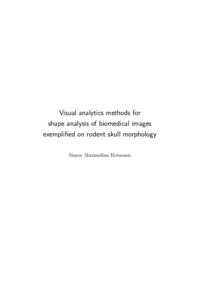Visual analytics methods for shape analysis of biomedical images exemplified on rodent skull morphology

Visual analytics methods for shape analysis of biomedical images exemplified on rodent skull morphology

| dc.contributor.advisor | Klein, Reinhard | |
| dc.contributor.author | Hermann, Simon Maximilian | |
| dc.date.accessioned | 2020-04-23T22:58:58Z | |
| dc.date.available | 2020-04-23T22:58:58Z | |
| dc.date.issued | 21.07.2017 | |
| dc.identifier.uri | https://hdl.handle.net/20.500.11811/7190 | |
| dc.description.abstract | In morphometrics and its application fields like medicine and biology experts are interested in causal relations of variation in organismic shape to phylogenetic, ecological, geographical, epidemiological or disease factors - or put more succinctly by Fred L. Bookstein, morphometrics is "the study of covariances of biological form". In order to reveal causes for shape variability, targeted statistical analysis correlating shape features against external and internal factors is necessary but due to the complexity of the problem often not feasible in an automated way. Therefore, a visual analytics approach is proposed in this thesis that couples interactive visualizations with automated statistical analyses in order to stimulate generation and qualitative assessment of hypotheses on relevant shape features and their potentially affecting factors. To this end long established morphometric techniques are combined with recent shape modeling approaches from geometry processing and medical imaging, leading to novel visual analytics methods for shape analysis. When used in concert these methods facilitate targeted analysis of characteristic shape differences between groups, co-variation between different structures on the same anatomy and correlation of shape to extrinsic attributes. Here a special focus is put on accurate modeling and interactive rendering of image deformations at high spatial resolution, because that allows for faithful representation and communication of diminutive shape features, large shape differences and volumetric structures. The utility of the presented methods is demonstrated in case studies conducted together with a collaborating morphometrics expert. As exemplary model structure serves the rodent skull and its mandible that are assessed via computed tomography scans. | |
| dc.language.iso | eng | |
| dc.rights | In Copyright | |
| dc.rights.uri | http://rightsstatements.org/vocab/InC/1.0/ | |
| dc.subject | Visualisierung | |
| dc.subject | Shape-Theorie | |
| dc.subject | Visual Analytics | |
| dc.subject | Morphometrie | |
| dc.subject | Volumen-Rendering | |
| dc.subject.ddc | 004 Informatik | |
| dc.title | Visual analytics methods for shape analysis of biomedical images exemplified on rodent skull morphology | |
| dc.type | Dissertation oder Habilitation | |
| dc.publisher.name | Universitäts- und Landesbibliothek Bonn | |
| dc.publisher.location | Bonn | |
| dc.rights.accessRights | openAccess | |
| dc.identifier.urn | https://nbn-resolving.org/urn:nbn:de:hbz:5n-47323 | |
| ulbbn.pubtype | Erstveröffentlichung | |
| ulbbnediss.affiliation.name | Rheinische Friedrich-Wilhelms-Universität Bonn | |
| ulbbnediss.affiliation.location | Bonn | |
| ulbbnediss.thesis.level | Dissertation | |
| ulbbnediss.dissID | 4732 | |
| ulbbnediss.date.accepted | 20.04.2017 | |
| ulbbnediss.institute | Mathematisch-Naturwissenschaftliche Fakultät : Fachgruppe Informatik / Institut für Informatik | |
| ulbbnediss.fakultaet | Mathematisch-Naturwissenschaftliche Fakultät | |
| dc.contributor.coReferee | Schultz, Thomas |
Dateien zu dieser Ressource
Das Dokument erscheint in:
-
E-Dissertationen (4077)




